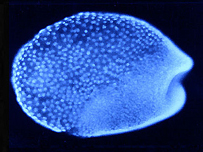images © 1999. Dr. Diethard Tautz
University of Köln

images of Tribolium development
| Tribolium early embryonic development images © 1999. Dr. Diethard Tautz University of Köln |  images of Tribolium development |
The segments in long germ-band insect embryos, like Drosophila, are all determined at the syncytial blastoderm stage. This is in contrast to short germ-band embryos, like Tribolium, which show an early determination of only the anterior head segments. In Tribolium the more posterior thoracic and abdominal segments are sequentially added after formation of a primary germ anlage.
Early cleavage and formation of blastoderm proceeds very similar to the process in Drosophila. The first nuclear divisions occur synchronously under syncytial conditions and the nuclei move toward the surface. Additional nuclear divisions occur at the surface, but these are no longer fully synchronous. Finally, it is believed that cellularization starts toward the end of this stage. Early acting zygotic segmentation genes like hunchback, Krüppel and hairy are first expressed during this stage.
At the end of blastoderm stage, an active movement of nuclei begins from the anterior dorsal region toward the posterior ventral region, where most of the nuclei will eventually form the germ anlage. Only a few nuclei are left in the anterior dorsal region, which appears to become larger (polyploid?) and which will eventually form the extra-embryonic serosa. The serosa nuclei express zerknüllt (zen), which at early blastoderm stage is restricted to the most anterior 10% of the embryonic nuclei. Thus one can conclude that most of the nuclei present at blastoderm stage will eventually end up in the germ anlage and have therefore, a chance to become specified (determined?) by a segmentation gene hierarchy acting at the blastoderm stage.
A second extraembryonic membrane, the amnion, forms from the rim of the germ anlage, mainly from its posterior part (the beginning folding of the amnion is visible in the picture), but also from the anterior and lateral parts. The amnion eventually extends ventrally, below the germ anlage.
The early germ band has now formed at the ventral side. Head lobes and growth zone are evident. The amnion has almost closed at the ventral side, leaving only a hole in the anterior third (visible in the picture). The serosa is still connected to the amnion.
The germband is now essentially a hollow tube formed by the embryonic material and by the fully closed amnion ventrally below it. It lies freely in the yolk, since the surrounding serosa has become detached. It begins to extend toward the posterior and becomes narrower.
All segments have formed at this stage, which is now again comparable to the Drosophila extended germband stage. Amnion and serosa will fuse again and are eventually engulfed into the gut.
Home page: The Interactive Fly © 1995, 1996 Thomas B. Brody, Ph.D.
The Interactive Fly resides on the
Society for Developmental Biology's Web server.